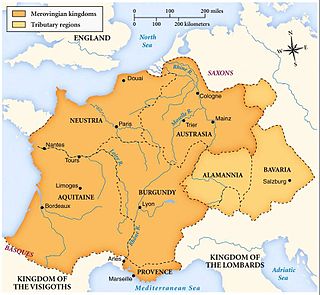
The Merovingian dynasty was the ruling family of the Franks from the middle of the 5th century until 751. They first appear as "Kings of the Franks" in the Roman army of northern Gaul. By 509 they had united all the Franks and northern Gaulish Romans under their rule. They conquered most of Gaul, defeating the Visigoths (507) and the Burgundians (534), and also extended their rule into Raetia (537). In Germania, the Alemanni, Bavarii and Saxons accepted their lordship. The Merovingian realm was the largest and most powerful of the states of western Europe following the breaking up of the empire of Theoderic the Great.

Clovis was the first king of the Franks to unite all of the Frankish tribes under one ruler, changing the form of leadership from a group of royal chieftains to rule by a single king and ensuring that the kingship was passed down to his heirs. He is considered to have been the founder of the Merovingian dynasty, which ruled the Frankish kingdom for the next two centuries.

Clotilde, also known as Clothilde, Clotilda, Clotild, Rotilde etc., was a princess of the kingdom of Burgundy. She was supposedly descended from the Gothic king Athanaric and became the second wife of the Frankish king Clovis I in 493. The Merovingian dynasty to which her husband belonged ruled Frankish kingdoms for over 200 years (450–758). Venerated as a saint by the Roman Catholic Church as well as by the Eastern Orthodox Church, she played a role in her husband's famous conversion to Christianity and, in her later years, became known for her almsgiving and penitential works of mercy. She is credited with spreading Christianity within western Europe.

Melun is a commune in the Seine-et-Marne department in the Île-de-France region in north-central France. It is a southeastern suburb of Paris 41.4 km from the centre of Paris. Melun is the prefecture of the Seine-et-Marne, and the seat of an arrondissement. Its inhabitants are called Melunais.

Étienne Baluze was a French scholar and historiographer, also known as Stephanus Baluzius.
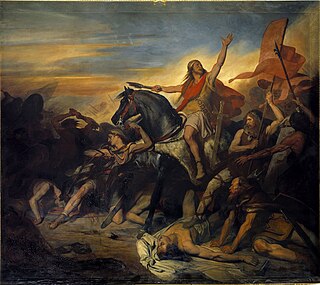
The Battle of Tolbiac was fought between the Franks, who were fighting under Clovis I, and the Alamanni, whose leader is not known. The date of the battle has traditionally been given as 496, though other accounts suggest it may either have been fought earlier, in the 480s or early 490s, or later, in 506. The site of "Tolbiac", or "Tolbiacum", is usually given as Zülpich, North Rhine-Westphalia, about 60 km east of what is now the German-Belgian frontier. The Franks were successful at Tolbiac and established their dominance over the Alamanni.

Clovis IV (c.677–694/695) was the king of the Franks from 690 or 691 until his death. If the brief reign of Clovis III (675) is ignored as a usurpation, then Clovis IV may be numbered Clovis III.
Chlodio also Clodio, Clodius, Clodion, Cloio or Chlogio, was a Frankish king who attacked, and apparently then held, Roman-inhabited lands and cities in the Silva Carbonaria forest, now in central Belgium, then Cambrai and Tournai, and reached as far south as the River Somme.

Childebert III the Adopted was a Frankish king.
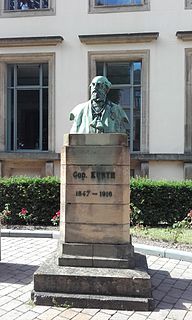
Godefroid Kurth (1847–1916) was a celebrated Belgian historian and pioneering Christian democrat. He is known for his histories of the city of Liège in the Middle Ages and of Belgium, his Catholic account of the formation of modern Europe in Les Origines de la civilisation moderne, and his defence of the medieval guild system.
André Duchesne was a French geographer and historian, generally styled the father of French history.
Liber Historiae Francorum is a chronicle written anonymously during the 8th century. The first sections served as a secondary source for early Franks in the time of Marcomer, giving a short breviarum of events until the time of the late Merovingians. The subsequent sections of the chronicle are important primary sources for the contemporaneous history. They provide an account of the Pippinid family in Austrasia before they became the most famous Carolingians.
Grimoald I (616–657), called the Elder, was the Mayor of the Palace of Austrasia from 640 to 656. He was the son of Pepin of Landen and Itta.

The Chronicle of Fredegar is the conventional title used for a 7th-century Frankish chronicle that was probably written in Burgundy. The author is unknown and the attribution to Fredegar dates only from the 16th century.
The title Duke of the Franks has been used for three different offices, always with "duke" implying military command and "prince" implying something approaching sovereign or regalian rights. The term "Franks" may refer to an ethnic group or to the inhabitants of a territory called Francia.
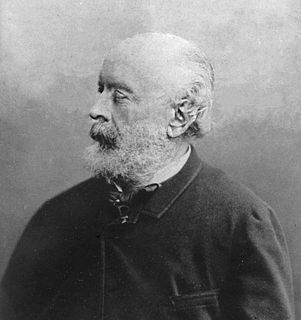
Évariste Vital Luminais was a French painter. He is best known for works depicting early French history and is sometimes called "the painter of the Gauls".
Leudesius was the son of Erchinoald, Mayor of the Palace of Neustria, and his wife Leutsinde.
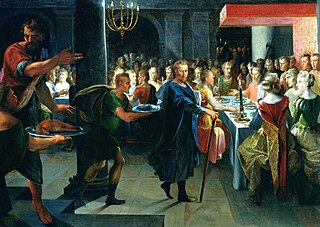
Francus is an invention of Merovingian scholars which referred to a legendary eponymous king of the Franks, a descendant of the Trojans, founder of the Merovingian dynasty and forefather of Charlemagne. In the Renaissance, Francus was generally considered to be another name for the Trojan Astyanax saved from the destruction of Troy. He is not considered to be historical, but in fact an attempt by medieval and Renaissance chroniclers to model the founding of France upon the same illustrious tradition as that used by Virgil in his Aeneid.
Aimoin was a monk of Saint-Germain-des-Prés from before 845. From 872 he was the abbey's chancellor (archivist) and chief copyist, overseeing the scriptorium. He was the teacher of Abbo Cernuus.

The Battle of Lucofao was the decisive engagement of the civil war that afflicted the Frankish kingdoms during and after the reign of Dagobert II (676–79). In the battle, the Neustrian forces of Theuderic III and his majordomo Ebroin defeated the forces of Austrasia under the dukes Pippin and Martin.













